10 Best Lightweight Safety Shoes for Comfort

April 30th 2025
Construction work is challenging and demanding. Workers' safety and comfort start from the ground up. For too long, safety boots felt like they weighed workers down, adding to fatigue and discomfort. But the game has changed. Modern technology brings us safety footwear that is genuinely lightweight and comfortable without sacrificing the crucial protection you need on-site. Let's find the best light weight safety shoe for comfort and durability.
The Top 10 Lightweight Safety Shoes for Construction Comfort
Here are 10 safety shoe options that stand out for their comfort and reduced weight, making them perfect companions for demanding workdays. We'll tell you what makes each one special.
1. Workland PKL Low Ankle Composite Toe Safety Shoe
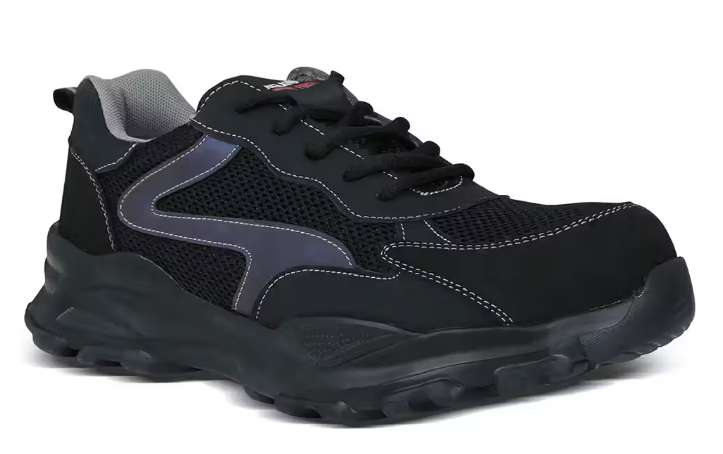
We selected the Workland PKL first because it embodies the modern lightweight safety shoe concept from the ground up. This shoe focuses on providing essential protection without any unnecessary bulk. It features a composite toe cap, a key factor in its reduced weight compared to traditional steel-toed boots.
The low ankle design offers maximum flexibility around the ankle, allowing for easy movement, bending, and crouching—actions you perform constantly on a site. The upper materials are often breathable synthetics or lightweight leather/suede blends that help manage heat in the UAE climate.
While specific S-ratings can vary by exact model variant, you can expect core safety features designed for site work. This shoe targets the worker who values agility and wants minimal restriction from their footwear while still meeting basic safety toe requirements. It's a grand entry into the comfortable, lightweight safety shoe world.
- Why it's lightweight & comfortable: The composite toe mainly contributes to its low weight. The low-ankle cut adds to a feeling of freedom and reduces bulk.
- Ideal for: Site supervisors, architects making frequent site visits, project managers, or workers in less hazard-intensive areas who still need toe protection and prioritise mobility and comfort.
2. Vaultex IMK Low Ankle Suede Leather Steel Toe Safety Shoes
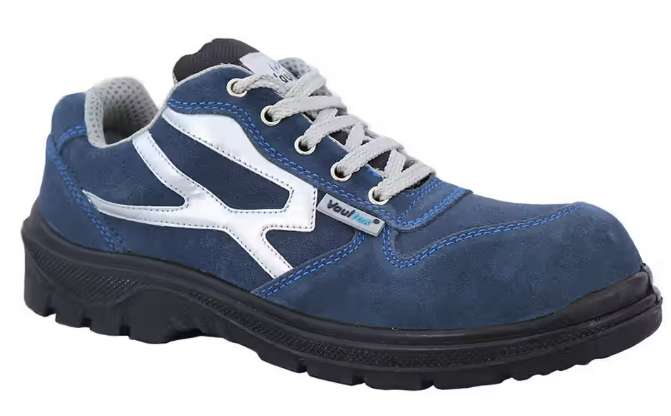
We included a steel-toe option in a "lightweight" list. The Vaultex IMK surprises many because Vaultex has engineered this shoe to minimise weight despite including a traditional steel toe cap. They achieve this through more innovative design, using lighter-weight outsole materials and streamlined upper construction.
The low ankle cut, similar to the Workland PKL, enhances flexibility. The upper's suede leather gives it a classic look while offering durability. Suede can also be more breathable than smooth leather in some constructions.
This shoe is often rated to core safety standards, typically including impact and compression protection from the steel toe, and usually boasts decent slip resistance. It caters to those who specifically prefer or require a steel toe (perhaps due to company policy or a specific hazard profile) but still want the closest thing to a lightweight safety shoe they can get with that feature. The blue colour also offers a refreshing change from standard black.
- Why it's lightweight & comfortable: Engineered design minimises steel toe weight impact; low ankle cut; suede can add some breathability. It's light for a steel-toe shoe.
- Ideal for: Workers who must wear steel-toe boots but want a less cumbersome option; those who prefer the traditional feel of a steel-toe but appreciate modern design for reduced fatigue.
3. Armstrong RKP Safety Shoes

The Armstrong RKP represents a solid, reliable option that focuses on balanced comfort and protection. Armstrong generally designs footwear with practical site use in mind. While specific detailed specs (like toe material without being stated) might require checking the product page, shoes like the RKP are often built with materials that offer a good compromise between durability, protection, and weight.
If this model incorporates composite safety features, it will contribute significantly to being a lightweight safety shoe. If it's steel-toe, the design focuses on overall mass reduction elsewhere. The RKP likely features robust outsoles designed for grip on various surfaces, an essential safety feature on any construction site.
This shoe fits well for general construction tasks where dependable safety meets everyday wearability. Its strength lies in providing reliable, comfortable protection for everyday construction activities.
- Why it's lightweight & comfortable: Designed for balanced performance, aiming to reduce weight without sacrificing robustness. Likely uses modern construction techniques.
- Ideal for: General construction workers, labourers, or anyone needing a dependable all-rounder safety shoe that avoids excessive weight.
4. Safetoe M-8027 S3 SRC High Ankle Steel Toe Heavy Duty Safety Shoes

You might raise an eyebrow when you see "High Ankle" and "Heavy Duty" on a lightweight list. We included the Safetoe M-8027 to make an important point: "lightweight" is often relative, and sometimes, the required safety features for extreme conditions necessitate a slightly more substantial build.
However, within the heavy-duty, high-ankle S3 SRC boots category, the Safetoe M-8027 is engineered to minimise weight compared to traditional counterparts offering the same level of protection.
This boot provides S3 SRC protection, meaning it offers steel toe protection, puncture resistance, antistatic properties, energy absorption in the heel, water resistance in the upper, and superior slip resistance (both SRA and SRB tested).
The high ankle design gives crucial support and protection for your ankle, which is vital on uneven or unstable ground or when working with heavy objects that could roll. While not as feather-light as a low-ankle composite toe shoe, it's lighter than most boots with this level of comprehensive protection. Safetoe focuses on integrating these heavy-duty features efficiently to keep the overall mass down.
- Why it's lightweight & comfortable (relatively): Engineered to be as light as possible while providing maximum S3 SRC high-ankle protection. Uses materials strategically. Provides excellent ankle support, which enhances comfort over long hours on rugged terrain.
- Ideal for: Workers in high-hazard environments, heavy construction, scaffolding, roofing, or sites requiring maximum ankle support and comprehensive S3 SRC protection. If your job demands heavy-duty, this is a light option.
5. Zecchin TBH Low Ankle Snow Composite Toe Safety Shoes
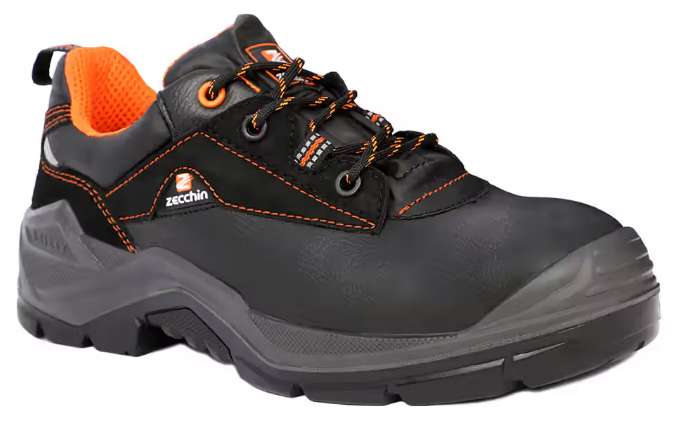
Don't let the "Snow" in the name mislead you about the UAE climate! This often refers to insulation properties or specific outsole compounds in colder climates. Still, in tropical/subtropical versions, the "Snow" aspect might translate to enhanced water resistance or particular materials. The key here is the Low Ankle design and the Composite Toe.
The Zecchin TBH is built as a lightweight safety shoe primarily using a composite toe, significantly reducing forefoot weight. The low ankle cut allows for maximum freedom of movement. Zecchin often designs for modern aesthetics and functional comfort.
This shoe focuses on agility and reduced fatigue for standard site activities where impact protection is key, but excessive ankle support isn't required. It's an excellent option for those who spend much time walking or kneeling and want their footwear to feel less like a burden.
- Why it's lightweight & comfortable: The Composite toe is the primary weight saver. Low ankle allows for flexible movement. The design likely incorporates materials that focus on comfort for prolonged wear.
- Ideal for: Site engineers, supervisors, interior fit-out teams, or any worker who needs essential toe protection and values high mobility and lightweight feel above all else.
6. Vaultex VJS6 High Ankle Safety Shoes
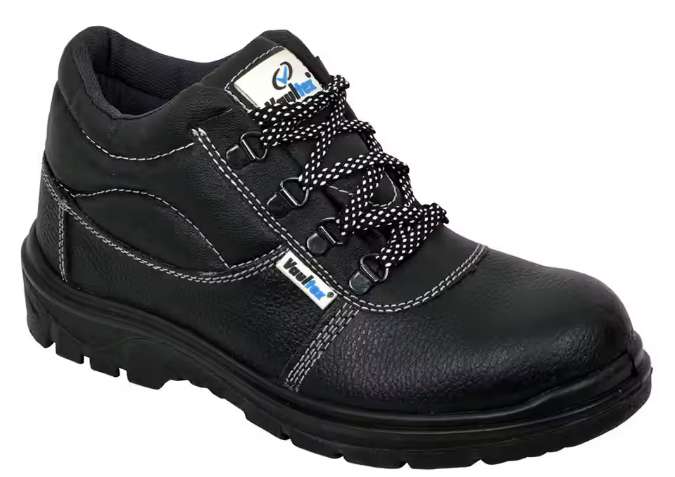
Vaultex appears again with a High Ankle model, the VJS6. This boot aims to provide the crucial ankle support needed on rough terrain or when handling materials, but it still attempts to manage overall weight. While likely heavier than its low-ankle counterparts, Vaultex uses construction methods and materials to prevent it from being overly cumbersome for a high-ankle boot.
The specific safety features (toe type, S-rating) would need confirmation on the product page. Still, High Ankle boots like the VJS6 typically aim for at least S1 or S3 standards, offering toe protection and often puncture and slip resistance.
The high ankle gives stability and comfort over difficult ground, reducing twists and strains. We recommend the VJS6 for workers who need that extra ankle stability but don't want the feeling of dragging genuinely heavy boots around all day. It finds a balance between necessary support and manageable weight.
- Why it's lightweight & comfortable: Engineered to minimise weight for a high-ankle boot, it provides ankle support, enhancing comfort and safety on uneven ground.
- Ideal for: Workers on uneven sites, groundworkers, landscapers within a construction context, or anyone prone to ankle rolls who needs a protective boot that isn't excessively heavy.
7. Zalat ZEX Low Ankle S3 SRA Composite Toe Safety Shoes
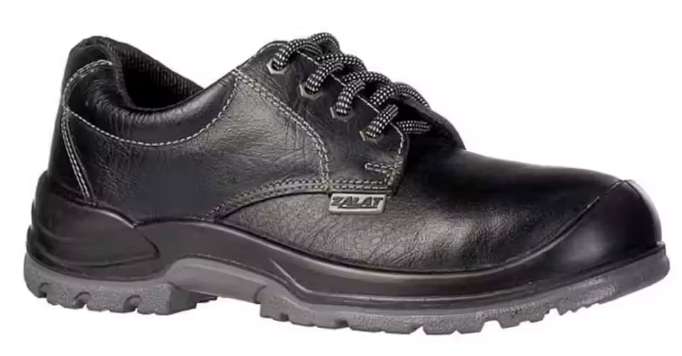
Here, we have another strong contender in the lightweight safety shoe category, offering comprehensive protection. The Zalat ZEX is an S3 SRA-rated shoe with a Composite Toe and Low Ankle design. This combination ticks many boxes for modern construction comfort and safety.
The S3 rating means it provides toe protection, antistatic properties, heel energy absorption, water resistance in the upper, and puncture resistance – essential for sites with sharp debris. The SRA rating guarantees good slip resistance on ceramic surfaces with detergent. The Composite Toe significantly contributes to its lightweight, making it comfortable for long shifts. The Low Ankle cut provides the freedom of movement many workers prefer.
We see the Zalat ZEX as an excellent all-around S3 lightweight safety shoe, perfect for general site conditions where you need puncture protection but want to avoid the weight penalty.
- Why it's lightweight & comfortable: Composite toe and low ankle cut are key. S3 rating provides comprehensive protection without adding unnecessary bulk inherent in older designs.
- Ideal for: Most general construction roles, electricians (composite is non-metallic), plumbers, site technicians, and anyone needing complete S3 protection in a light, flexible package.
8. Miller SOH Low Ankle Safety Shoes
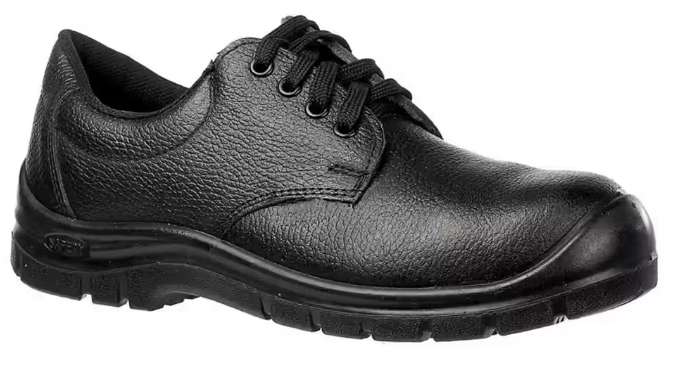
Miller safety shoes often focus on durable construction designed for harsh environments. The SOH model, featuring a Low Ankle design, is built to be resilient while aiming for wearability.
Like others on the list, the specific toe material (steel or composite) will dictate its ultimate weight relative to other models. However, Miller's design principles usually involve robust materials chosen for longevity, balanced with features promoting comfort.
A low-ankle shoe like the Miller SOH facilitates quick changes in direction and easy bending, reducing strain over a long day. While not the absolute lightest on the list, if it features a steel toe, its construction prioritises durability and protection in a low-profile format, making it feel less cumbersome than a traditional heavy boot.
The Miller SOH as a workhorse light-weight safety shoe – built tough, designed for comfort, and focused on practical performance on site.
- Why it's lightweight & comfortable: Low ankle cut provides flexibility; designed for durability using materials balanced for weight and strength.
- Ideal for: Workers who are tough on their footwear need a durable, low-ankle shoe for general site duties, where reliability and a comfortable fit are paramount.
9. Workland VCN Sports Composite Toe Safety Shoes
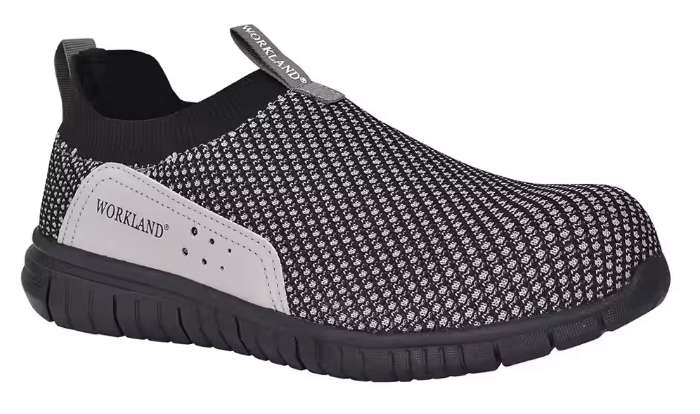
Here's where the line between work and athletic shoes gets delightfully blurred. The Workland VCN Sports model takes inspiration from athletic footwear design to maximise comfort and reduce weight while still incorporating essential safety features. It features a Composite Toe, which is fundamental to its lightweight feel.
The "Sports" designation usually means the shoe incorporates features like enhanced cushioning in the sole, breathable mesh panels in the upper, and a flexible construction that mimics the feel of a running or training shoe. This design focus makes it incredibly comfortable for tasks involving walking or standing.
While it might lack a heavy-duty boot's extreme ruggedness or water resistance, it's perfect for lighter construction tasks, supervisory roles, or indoor site work where the primary need is toe protection and all-day comfort without weight dragging you down. This epitomises a modern, comfortable, lightweight, and safe shoe.
- Why it's lightweight & comfortable: Uses a composite toe; design draws from athletic shoe technology for maximum cushioning and flexibility; potentially incorporates breathable materials.
- Ideal for: Site supervisors, foremen, architects, engineers, interior fit-out workers, quality control inspectors – anyone who spends significant time walking on site and prioritises comfort and agility.
10. Armstrong GRCP Low Ankle Steel Toe Safety Shoe
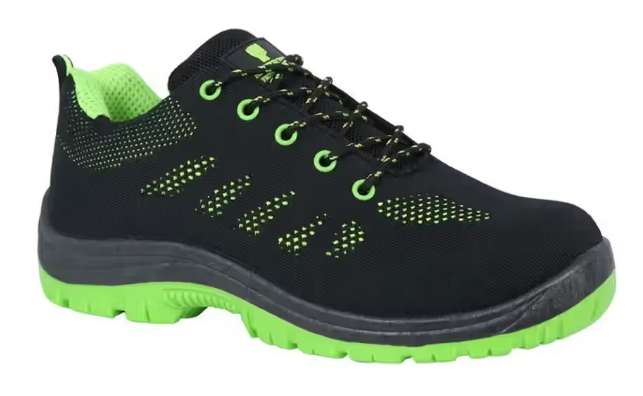
Rounding out our list is another reliable option from Armstrong, the GRCP. This model features a Steel Toe, but like the Vaultex IMK, Armstrong works to keep the overall weight manageable for a steel-toed shoe. The Low Ankle design again provides flexibility and reduces overall bulk.
The Armstrong GRCP is built for practical, everyday site use. It will provide dependable toe protection and likely features a durable outsole suitable for various surfaces. The splash of green adds a bit of style to the functional black.
This shoe serves the worker who prefers the feel or needs the specific properties of a steel toe but appreciates a low-ankle format that feels less heavy and restrictive than traditional high-ankle steel boots. It's a solid, no-nonsense, lightweight, safety shoe option for those who favour traditional protection with modern wearability.
- Why it's lightweight & comfortable: Low ankle design reduces weight and increases flexibility; it is engineered to be a manageable weight for a steel-toe shoe.
- Ideal for: General labourers, trade workers, or anyone needing a reliable steel-toe low-ankle boot designed to be less fatiguing than older models.
How To Choose the Best Light Weight Safety Shoe?
So, you've seen some fantastic lightweight safety shoe options. How do you pick the perfect one for you? It boils down to a few key factors:
- What are the specific hazards of your job? Do you need puncture resistance (S3)? Is slip resistance (SRC) critical? Do you need ankle support (High Ankle)? Let your job requirements dictate the minimum safety standard you need.
- What's your work environment like? Wet or dry? Indoor or outdoor? Smooth concrete or rough, uneven ground? This affects the S-rating needed and the type of outsole and upper material that will be most comfortable and durable.
- Steel Toe vs. Composite Toe? If your job doesn't mandate steel, a composite toe is generally the easiest way to reduce weight and often improve comfort (no temperature conductivity).
- Low Ankle vs. High Ankle? Low ankle offers maximum flexibility and generally lower weight. High ankle offers crucial ankle support on challenging terrain. Choose based on the ground you work on and your need for stability.
- Personal Preference & Fit: Fit is paramount in shoes. Consider the materials, the lacing system, the insole cushioning, and how the shoe feels when you flex your foot. Even the lightest safety shoe is uncomfortable if it doesn't fit correctly.
Frequently Asked Questions (FAQs)
Q. Are lightweight safety shoes less protective than traditional heavy ones?
No. Lightweight safety shoes use advanced materials and designs (like composite toes) to meet the same safety standards (e.g., EN ISO 20345 S3) as heavier boots. A certified lightweight shoe offers the same tested protection level as a heavier one with the same rating.
Q. What's the main difference in weight between a steel toe and a composite toe?
A composite toe is significantly lighter than a steel toe, providing equivalent impact protection. This weight difference is key to a lightweight safety shoe. Composite also doesn't conduct temperature or trigger metal detectors.
Q. How do I choose between a low-ankle and high-ankle lightweight safety shoe?
Low-ankle shoes offer lighter flexibility and are ideal for flat ground or bending tasks. High-ankle boots provide ankle support and stability on uneven ground or where ankle injury risk is higher. Choose based on your site conditions and support needs.
Q. Does 'lightweight' mean less durable?
Not if the shoe is well-made. Durability comes from the quality of materials and construction, not just weight. Good lightweight safety shoes use strong, engineered materials balanced for reduced weight and resilience.
Q. What does the S3 rating mean, and is it essential for lightweight shoes?
S3 is a high standard: safety toe, antistatic, heel energy absorption, water resistance, puncture resistance, and good grip (cleated outsole). Many lightweight shoes, especially composite-toe ones, are S3-rated. If your job involves sharp objects, water, or uneven ground, S3 is essential and available in lightweight options.
Q. How often should I replace my safety shoes?
Inspect them regularly for daily construction use. Replace them when you see significant wear, damage to safety features, or loss of support and comfort, typically every 6 to 12 months.
Q. Can I get wide-fit options in lightweight safety shoes?
Yes, many lightweight safety shoes, including those we offer, are available in wider fit options. Check the specific product details on our website for sizing information.
Final Words
Always seek out the options designed for maximum comfort and minimal weight. A lightweight safety shoe isn't a luxury; it's a wise investment in your well-being and performance.
We've shown you some top contenders, highlighting how modern design delivers safety without the traditional weight penalty. Now, we invite you to explore the full range. FEPY has an extensive collection of safety shoes, gear, and accessories.
Browse our extensive collection of safety shoes to find the perfect pair tailored to your specific job requirements and comfort preferences. See all the models, compare features, and read detailed specifications.
We have good news for you if you want to buy in bulk. You are entitled to get massive discounts on bulk buying. Become a FEPY PRO member. You will get multiple benefits, including the quickest delivery, priority support, credit facilities, and more. Connect with our customer care to learn more about this exclusive service.